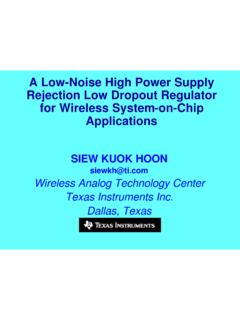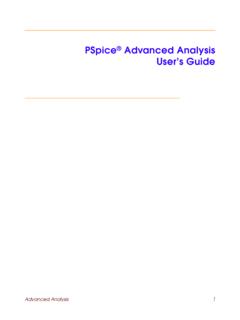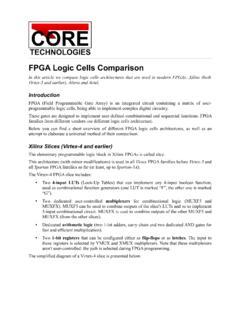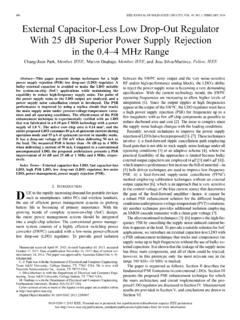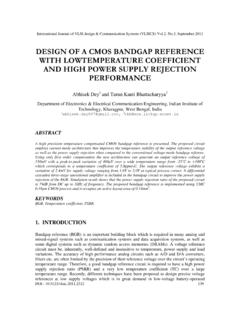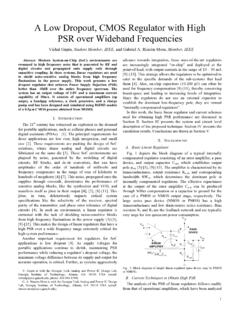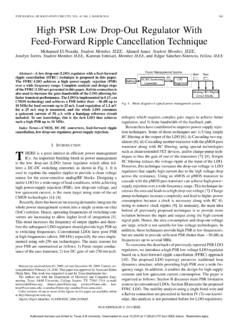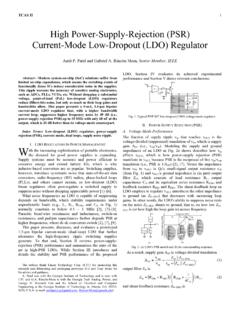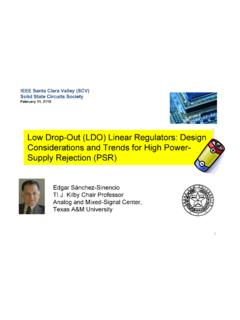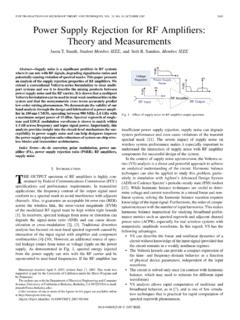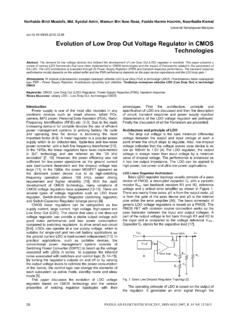Transcription of A Low Noise, High Power Supply Rejection Low Dropout ...
1 A Low Noise, high Power Supply Rejection Low Dropout Regulator for wireless system -on-Chip ApplicationsS. K. HOON(1), S. CHEN(1), F. MALOBERTI(2), J. CHEN(3), B. ARAVIND(1)(1) wireless Analog Technology Center, Texas Instruments, Dallas (2) Department of Electronics, University of Pavia, Italy (3)Analogic Tech, Dallas Abstract - This paper presents a novel two-stage low Dropout regulator (LDO) that minimizes output noise via a pre-regulator stage and achieves high Power Supply Rejection via a simple subtractor circuit in the Power driver stage. The LDO is fabricated with a standard CMOS process and occupies and for single and dual output respectively. Measurement showed PSR is 60dB at 10kHz and integrated noise is ranging from 1kHz to 100kHz. I. INTRODUCTION Recently, there is a lot of focus on designing high performance low Dropout regulator (LDO) with low noise and high PSR specification due to the wide spread popularity of hand-held products such as cellular phones and PDA (Personal Digital Assistant) [1].
2 The high performance LDO is commonly employed as radio frequency (RF) LDO providing quiet Power Supply in wireless RF system . Generally, a LDO is a closed-loop system consisting of an error amplifier, a resistive feedback network and a series pass transistor (PMOS in this case) as shown in A1-+VBG (Voltage Reference)( )VDD (Battery Supply )Resistor feedback networkR1R2CL (Load Capacitor)( uF)Load CurrentPass Transistor (PMOS)VOUT (Output ) Conventional LDO In , The DC value of LDO output (VOUT) can be expressed as +=211 RRVVBGOUT (1) where VBG is the voltage reference and is generally the output of a quiet voltage source such as the bandgap reference. Two specification parameters [2][3] that are usually of challenge are the Power Supply Rejection and low integrated noise. A.
3 Power Supply Rejection Power Supply Rejection (PSR) measures the LDO s ability to suppress Power Supply noise from its output. Assuming the contribution of Supply noise due to the bandgap reference is negliglible, the small signal variations of vout due to Supply noise (vdd) is given by )(1outdspmpddddoutvrgAvAv += (2) where Add is the Power gain vout/vdd, and A1 is the open-loop gain of the error amplifier, is the feedback factor R2/(R1+R2),gmpand rdsp are the transconductance and output impedance of the pass transistor PMOS respectively. Using the methodology as in [4], the output of LDO due to total Power Supply noise at low frequency can be further shown as [5] dddspmppoutvArgAAv + = 111111 (3) where Ap1 is the Power gain = v1/vdd. From (3), to achieve high PSR, an easy technique to improve PSR is to increase the error amplifier gain A1 and reduce the gain factor 1/ if possible.
4 Alternatively, one should try to design the error amplifier such that Ap1 1. For this to happen, v1needs to be close to vdd which means having the voltage at V1 tracks with the voltage at the source terminal of pass PMOS (which is connected to Power Supply ). B. Integrated Noise Another important circuit performance is the total integrated noise of a LDO over the band of interest (f2- f1). In conventional design, the total noise of the regulator is mainly contributed by different noise sources as illustrated in Vn_R1 and Vn_R2are equivalent noise voltage of R1 and R2,Vn_BGis the bandgap noise and Vn_inis the input-referred noise of error amplifier itself. The total noise Power Vn12due to the resistor feedback network is given by 21_221_2121 RnRnnVRRVV += (4) 26-7-1 IEEE 2005 CUSTOM INTEGRATED CIRCUITS CONFERENCE0-7803-9023-7/05/$ 2005 The total noise Power Vn22due to the noise seen at the input of LDO is given by 2_2_2211 + =BGninnnVVV (5) The integrated noise Vn_o2 (f2 - f1) is given by () +=2122212_ffnnondfVVV + + +=212_2_21_221_1121ffBGninnRnRndfVVVRRV (6) where 1/ is the closed-loop gain of the LDO decided by the ratio of VOUT and VBG (VOUT/VBG= 1/ ).
5 There are two ways to reduce Vn_o2 : (a) increase the transistor s area of first stage (such as input pair) and current consumption of the error amplifier in order to reduce Vn22. (b) reduce the values of R1and R2 in order to reduce Vn12. This will also result in an increase in the quiescent current consumption. In the case of system -on-chip (SoC) application, several similar LDOs can co-exist on the same chip and the increase in area and current consumption can become a serious problem. R1R221_RnV22_RnV2_BGnV2_innV-+ Noise sources of conventional LDO .II. IMPROVED LDO A. Power Supply Rejection improvement From (3), the PSR can be improved by having Ap1 1. Thus, the basic idea to improve PSR is to have an additional voltage subtractor stage as shown in inserted between the pass PMOS and the error amplifier, which feeds the Supply noise directly into the feedback loop and modulates the pass PMOS gate with respect to the source terminal.
6 Note that the input terminals to the error amp need to be reversed with the addition of subtractor which would produce a phase inversion in the loop. The subtractor can be easily implemented using two NMOS transistors illustrated in Using a two-stage miller amplifier [4], the contribution of Supply noise at V2would be small compared to the Supply noise at diode MN1, thus v2 (the gate voltage at MN2) = 0. The output of subtractor stage is given by (via resistance division) dddsNmNdsNvrgrv2121/1+= (7) where gmN1 and rdsN2are the transconductance of N1 and output impedance of N2 respectively. If gmN1 >> gdsN2, eq.(7) would become v1/vdd 1 or Ap1 1 (8) Thus, with (3) and (8), it can be shown that the PSR of the modified LDO, is improved and given by 12111 AggrgvmNmNdspmpout= (9) Both transconductance of the NMOS transistors (gmN1 and gmN2) can be made equal.
7 This ensures the loop-gain does not increase which could jeopardize the stability of the system . Similar results can also be observed if MN1 is replaced by a PMOS MP11 with gate and drain terminals tied in a diode connection. The LDO is internally compensated via (Battery Supply )Load Current( Max @ 50mA)Pass Transistor (PMOS)Output ( )MN2 Voltage Reference( ) Implementation of PSR-boost technique The diode connection of the subtractor provides a low impedance node (1/gm) to push the parasitics pole of the pass PMOS, leaving the dominant pole due to the main miller loop (via Cc1) at node X. Another non-dominant pole at node Y is pushed away by the secondary miller loop(via Cc2). B. Noise improvement From (6), the total noise can be improved by reducing the gain factor 1/ and eliminating the noise term due to the resistors noise.
8 The improvement can be made by a two-stage architecture which consists of a pre-regulator and a Power driver stage as shown in The pre-regulator stage is formed by a reference buffer for level-shifting the bandgap-reference voltage and a RC low pass filter (LPF). Note that the bandgap reference voltage is typically fixed ( ) and serve as general reference voltage mainly for the rest of the 26-7-2760low noise modules such as baseband or RF channels. The Power driver is a voltage follower configuration with a pass PMOS as its final stage so as to be able to drive the required current load. The output noise of each LDO Vn_o equals to ++=212_2_2_11ffpreninnondfVsRCVV (10) where Vn_in is the input referred noise of the Power driver itself and Vn_preis the output noise of the pre-regulator.
9 If the LPF s cut-off frequency is well below the starting frequency f1, the second noise term in (10) can be filtered off and the final output noise can be simplified to () =212_2_ffinnondfVV (11) Pre-regulator+-FilterReference VoltageR2R1 Output (V2)Output (V1)Vpre+-+- Power Driver 2 Power Driver Proposed low noise regulators with dual output Comparing with (6), the only noise term left in (11) is the input-referred noise of Power driver. In addition, the input-referred noise does not contain any gain factor 1/ .It is apparent that the larger the feedback factor 1/ , which means a low bandgap reference voltage and a high output voltage setting, the larger it would be the difference in noise performance. The proposed architecture also has the following advantages: (a) LDOs with the same output voltage setting can share the same pre-regulator and LPF.
10 The area savings are significant especially in the SoC applications where several LDOs of similar specifications are required to be on the same chip. (b). The PSR is further improved by a factor of , since the Power driver is a unity gain feedback Power amplifier, the Supply noise seen at output is then given by (using the subtractor stage in the Power driver) 12111 AggrgvmNmNdspmpout= (12)The filter in can be implemented by a simple first-order RC filter. Since the density of on-chip capacitor is low (eg. 4fF/ m2), normally the filter capacitor C is set smaller than 100pF to save area. Therefore, the resistance of R should be hundreds of Mega-ohms if the filter s cut-off frequency is set to be less than 10 Hz. Certain CMOS processes have very high -density on-chip resistor (eg.)
